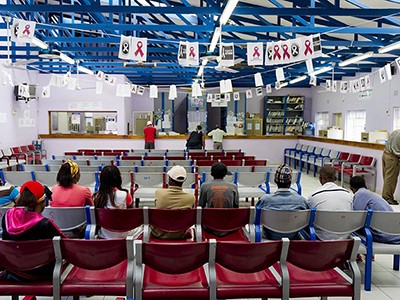Amid the COVID-19 pandemic, a milestone of another global scourge has largely escaped the spotlight. It has been 40 years since the earliest reports of what ultimately became known as AIDS, in 1981. I initially dismissed the first report as a curiosity and probably a fluke, but another a month later, from the US Centers for Disease Control and Prevention, changed my mind and the direction of my career. Against the advice of my mentors, I shifted my research focus to understanding why young, healthy men were being beset by unusual conditions. I remember anxiously awaiting results essential in the fight against a disease that brought on so many seemingly unrelated symptoms: pneumonia, blindness, skin lesions, dementia.
This year’s World AIDS Day, on 1 December, marks both incredible progress and the need for more. HIV was shown to be the cause of AIDS in 1983–84. Soon, there were blood tests for diagnosis, and for screening the supply of donated blood. These revealed the enormous scope of the pandemic: between 1984 and 1985, new cases of AIDS in the United States almost doubled. Eventually, progress in understanding — getting the sequence of the virus’s genome, and comprehending how it decimated the immune system and how disease progressed — paved the way for dozens of approved therapies.
In 1985, a 25-year-old in the United States diagnosed with AIDS had a life expectancy of less than two years. Today, a person with HIV can expect to die in old age, of other causes. Since the global peak in 2004, AIDS-related deaths are down by 64%. Overall, about 73% of people with HIV are accessing treatment. Still, in 2020, almost 700,000 people died from AIDS-related illnesses and 38 million were living with HIV.
Millions of people have also been killed and disabled in the COVID-19 pandemic. The fight against HIV reveals how important it is to make use of existing treatments and strategies for prevention, to strive for better ones, to reach vulnerable communities and to consider equity, education and outreach. There are many similarities that sadden me: how hard some patient groups need to fight for recognition; how misinformation and denialism can promote illness and death; how slowly interventions reach vulnerable populations; how easy it can be to overlook patient inputs when setting research priorities.
The 40 years of AIDS have been punctuated by periods of both darkness and hope. In the early, frustrating days of the pandemic, physicians had little to offer our patients. Glimmers of hope came with treatments for opportunistic infections and the first partially effective antiretroviral drugs. In the mid-1990s, multidrug antiretroviral regimens transformed the prognoses of many people infected with HIV from dire to excellent. Now, more potent, better-tolerated drug combinations are available as a single daily pill.
A crucial lesson was that antiretroviral therapy both helps the person living with HIV and reduces their risk of transmitting it: treatment cuts the level of the virus in their blood until it can neither be detected nor passed on. Understanding that ‘undetectable equals untransmittable’ was a triumph of research, as well as of HIV activism, which has been a driving influence throughout this journey. Also transformative is pre-exposure prophylaxis: giving people antiretrovirals before they are exposed to HIV can be more than 95% effective in preventing them from acquiring it. I suspect that drugs based on monoclonal antibodies will soon play an important part in treating and preventing HIV, as they do for SARS-CoV-2.
Medical advances mean that HIV/AIDS could, theoretically, now be taken off the table as a major health threat (in the United States and globally), particularly if programmes such as the President’s Emergency Plan for AIDS Relief and the Global Fund to Fight AIDS, Tuberculosis and Malaria continue to get robust support. Sadly, things are never that simple. Uptake of treatment remains suboptimal, in rich and poor communities. Reasons include lack of transport, substandard housing, mental-health issues, substance abuse, pill fatigue, drug toxicity, stigma and discrimination.
And so, a top priority is to ensure that everyone has access to existing treatment and prevention options, while we develop better ones. Earlier this year the first long-acting injectable antiretroviral treatment regimen, cabotegravir + rilpivirine, delivered once a month, was approved by regulatory authorities. An injectable, long-acting form of cabotegravir might soon be approved for prophylactic use.
Exciting work is under way for further HIV treatment and prevention. This includes development of very long-acting drugs that could be taken every six months or even less frequently. And then there are strategies for achieving durable HIV remission. Some people are working on eradicating the replication-competent HIV reservoir (a concept frequently referred to as a cure).
A safe and effective HIV vaccine has been elusive so far, but even a moderately effective vaccine could, together with the rest of the toolkit, bring an end to AIDS as a major health concern. It’s likely that one could build on some of the tools and platforms used for COVID-19 vaccines, including messenger RNA and optimizing immunogens to prompt the most effective immune response.
Entering the fifth decade of AIDS, the challenge to researchers is to work with at-risk communities to deliver treatment and prevention to everyone in the world who needs them.
Article From & Read More ( Victories against AIDS have lessons for COVID-19 - Nature.com )https://ift.tt/3rjGN0w
Health

No comments:
Post a Comment